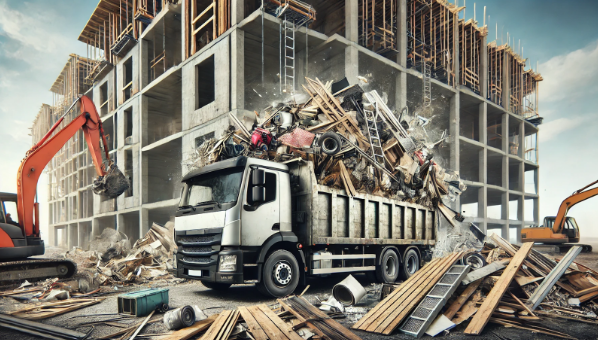
The Complete Guide to Efficient Construction Debris Removal
Construction projects, whether big or small, come with one inevitable outcome—debris. From concrete chunks to wood scraps, managing construction waste can be a challenge if you’re not prepared. A clean site not only looks better but also improves safety and keeps projects on schedule.
What Is Construction Debris Removal and Why Is It Important?
Construction debris removal involves clearing and disposing of the waste materials generated during construction, renovation, or demolition projects. This includes everything from drywall, concrete, and bricks to packaging materials and scrap metal.
Key Reasons to Prioritize Debris Removal:
- Safety: Unmanaged debris can be a trip hazard and cause injuries on-site.
- Efficiency: A clean work area speeds up progress and reduces delays.
- Compliance: Proper disposal ensures you meet local regulations and avoid hefty fines.
- Sustainability: Recycling and responsible disposal reduce the environmental impact of construction projects.
Step-by-Step Guide to Construction Debris Removal
Step 1: Assess the Type and Volume of Debris
Before you can plan for debris removal, you need to know what you’re dealing with. Different types of waste require different disposal methods.
- Common types of construction debris:
- Concrete, bricks, and tiles
- Wood and lumber
- Metal scraps
- Drywall and insulation
- Packaging materials (plastic, cardboard)
- Hazardous materials (paint, chemicals)
- How to assess volume:
- Walk through the site and take inventory.
- Estimate the amount of waste by type to determine disposal needs.
- Consider renting a dumpster or hiring a removal service if the volume is high.
Step 2: Sort and Separate Your Debris
Sorting debris at the source saves time and money in the disposal process. Separate materials into categories:
- Recyclable: Metals, concrete, and certain plastics can be recycled.
- Reusable: Wood and fixtures may be repurposed.
- Hazardous waste: Items like paint cans and asbestos require special handling.
- General waste: Items that cannot be recycled or reused.
Step 3: Choose the Right Disposal Method
Once sorted, you can decide how to dispose of the debris efficiently.
- Recycling: Contact local recycling centers for items like metal, concrete, and plastics.
- Donation: Usable materials such as fixtures, cabinets, or wood can be donated to organizations like Habitat for Humanity.
- Renting a Dumpster: Ideal for large projects with significant waste. Make sure to rent one that’s appropriately sized for your needs.
- Professional removal services: If you're short on time, consider hiring professionals who handle everything from loading to disposal.
The Benefits of Hiring a Professional Construction Debris Removal Service
Managing construction waste can be a headache, especially for large projects. Here's why hiring professionals is often a smart move:
- Time-saving: Allows your crew to focus on the project instead of waste disposal.
- Safety: Trained professionals handle hazardous materials safely.
- Eco-friendly practices: Professional services often prioritize recycling and sustainable disposal.
- Compliance: They stay updated on local regulations to avoid fines.
| Service Type | DIY Approach | Professional Service |
|---|---|---|
| Time Investment | High (requires planning and labor) | Low (handled by professionals) |
| Safety | Risk of injury | Safe and compliant |
| Cost | Lower upfront but hidden costs | Higher but transparent pricing |
| Environmental Impact | May miss recycling opportunities | Focused on eco-friendly disposal |
Sustainable Construction Debris Management: Best Practices
Taking a sustainable approach to construction waste management benefits not only the environment but also your business’s reputation. Here’s how to do it:
1. Plan Ahead for Waste Management
- Create a waste management plan before starting your project.
- Set recycling goals to minimize waste that goes to landfills.
- Communicate with your team about proper sorting and disposal procedures.
2. Prioritize Recycling
- Concrete and asphalt: Can be crushed and reused in new construction projects.
- Metal: Scrap metal can be recycled for new steel products.
- Wood: Untreated wood can be chipped into mulch or reused in landscaping.
3. Opt for Reusable Materials
- Salvage materials like bricks, tiles, and windows from demolition sites.
- Sell or donate reusable items to local charities or other projects.
4. Use Eco-Friendly Disposal Services
- Partner with junk removal services that prioritize green disposal.
- Ensure hazardous waste is handled by certified professionals.
FAQs on Construction Debris Removal
Q1: How can I estimate the cost of construction debris removal?
The cost varies depending on the volume, type of debris, and whether you hire a service or rent a dumpster. On average, expect to pay between $300 to $700 for a mid-sized project.
Q2: Can construction debris be recycled?
Yes, many materials like metal, concrete, and certain plastics can be recycled. Check with local recycling centers for specifics.
Q3: What is considered hazardous waste in construction?
Common hazardous materials include asbestos, old paint, solvents, and certain types of insulation. These require special handling and disposal.
Q4: Is it better to rent a dumpster or hire a junk removal service?
If you have a large volume of waste and can handle the labor, renting a dumpster may be more cost-effective. For smaller projects or hazardous waste, a removal service might be better.
Quick & Reliable
We are available by phone or email
CITIES WE SERVICE
Benton, LA
Minden, LA
SERVICES
All Rights Reserved | LEFTOVERS Junk Hauling & Roll-Off Dumpsters
